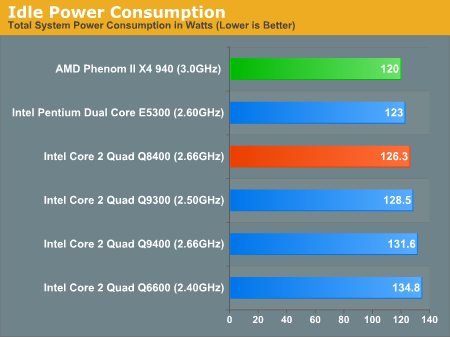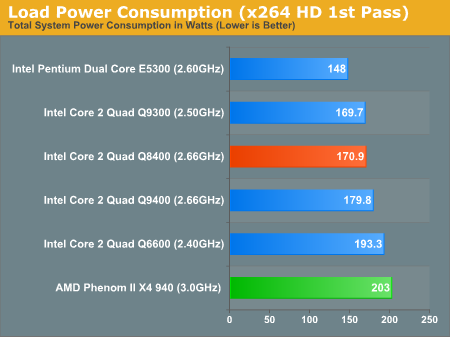The Core 2 Quad Q8400: Intel's $183 Phenom II 940 Competitor
by Anand Lal Shimpi on May 7, 2009 12:00 AM EST- Posted in
- CPUs
Power Consumption
AMD did a lot of work on reducing idle power consumption with the move to Phenom II and thus we see the 758M transistor X4 940 draw less power than even the Q8400 at idle.

Under load it's a different story entirely, the Phenom II X4 940 needs another 32.1W. Granted it's a faster chip, but with all of those transistors switching at 3GHz the power consumption is simply higher.











60 Comments
View All Comments
TA152H - Friday, May 8, 2009 - link
Anand,Have you ever asked Intel why they don't lower the latency of their processors when they cut the cache size? Why should a processor with two MB cache run at the same latency as one with six MB? Certainly it does not need to.
I could understand it where they are just cutting off some of the cache because it's faulty, but when they are actually two different dies, with the different cache sizes designed into the chip, why do they artificially slow down the chips with the smaller cache? They should have no trouble lopping off one cycle, since the 4 MB Conroes were 14 instead of 15, and these processors are 2 MB cache per core, so it could allow 13 cycles, but surely can handle 14 easily.
It's maddening when Intel slows things down for no good reason. It's probably a marketing decision, and we all know how marketing decisions are.
Anand Lal Shimpi - Friday, May 8, 2009 - link
It actually comes down to design resources. It's fairly easy to change a cache size, but changing the access latency requires more of a design change. I'm guessing those resources are better spent on newer architectures. e.g. Intel could go back and make even better versions of the Penryn based cores, but it makes more sense to put those efforts into engineering Westmere and its successors.Plus, a given architecture is usually optimized for whatever latency cache it's originally designed with. Speeding up the L2 may not yield as big of a gain as it would had the architecture been originally designed around a faster L2.
I believe there's always a focus on lowering cache latencies, and that's what we saw with Nehalem. From what I've heard, the new focus is bringing down that L3 latency...
Take care,
Anand
Seramics - Friday, May 8, 2009 - link
I noticed a strange trend in Phenom II X3 720 performance. They consistently performed very well, always outperforming similarly clocked buy quad core model of PII X4 920 and sometimes even besting PII X4 940. Strange... wonder why is that... the only advantage of 720 over quad models is higher L3 cache per core... but still, i would thought even 920 should be better.... strange strangecfaalm - Friday, May 8, 2009 - link
Why are we getting new Core2 models in the first place? Shouldn't Intel be selling us i5 rather sooner than later?garydale - Friday, May 8, 2009 - link
In almost every benchmark the AMD chip bested the (cheaper) Intel - often by a noticeable margin. The real competition for the 940 remains the 9400. A better comparison would have been between the 8400 and one of AMD's comparably-priced CPUs.Still, with VT disabled on the 8400, we're talking apples and oranges. I don't know what Intel were thinking by disabling it but seems remarkably silly with virtualisation even hitting home users these days. It's quite like disabling SSE but the idea seems like a win for marketing over engineering. Pay the extra $30 and get a CPU.
ssj4Gogeta - Saturday, May 9, 2009 - link
I can't understand what all this fuss is about. As if everyone in the world is going to be running the Ultimate version of Windows.LoneWolf15 - Friday, May 8, 2009 - link
Intel VT as well.Sorry, I think my Q6600 is worth more than a Q8400 for that reason alone. I'm also pretty sure that AMD's hardware virtualization trickles down to a cheaper level than Intel's does.
Intel really needs to stop cutting VT on all but perhaps Celeron-class CPU's and maybe Pentium Dual-Core on laptops. I certainly wouldn't buy anybody's quad-core that didn't have it.
leexgx - Friday, May 8, 2009 - link
all AM2 or higher chips have amd-V (apart from semprons None of them have amd-V), i think some 939 cpus have amd-V not sure but not the point realy as thay not been sold for yearsall q8000 cpus do not have VT (unless thay bring one out that does), q9000 do
Scali - Friday, May 8, 2009 - link
Yup, AMD leaves VT enabled on pretty much everything.Makes sense, because it's an added value over Intel's offerings, and it doesn't cost much extra, since it's already in the chip design.
For Intel it makes sense to leave it disabled, because it's a feature that's mainly useful for business users, and Intel has always tried to push business users to the high-end CPUs by disabling certain features on the lower-end models. Performance alone isn't really a reason to get a high-end CPU anymore.
LoneWolf15 - Friday, May 8, 2009 - link
It will be useful for far more than business users shortly. Windows 7's new XP-mode option requires Intel VT or AMD-V. While I admit that so far I haven't had app issues under Win7RC (that includes 32-bit app issues in a 64-bit environment) there IS one 16-bit app I still run that I'm sure I'll need XP mode for under 64-bit Windows. I'm also sure there will be other instances that pertain to the general market.Eventually, hypervisors are going to be a big deal, just like multi-core processors are becoming now. At that point, people without Intel VT will be screwed, and I think they'll be pretty ticked if they're the ones that thought that buying a quad-core CPU like the Q8400 was a good future-proofing move.